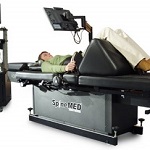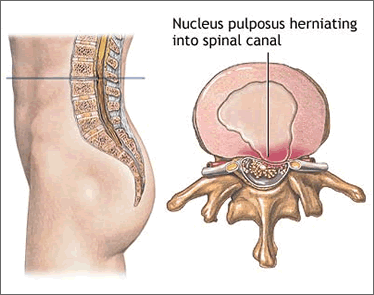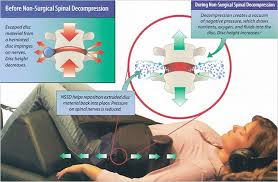Spinal Decompression

YOU MAY BE ABLE TO AVOID SURGERY WITH SPINAL DECOMPRESSION THERAPY
Dr. Jared Norman, Nevada Spine and Disc
How powerless is it to hear “We’ve done all we can do for you, you’re just going to have to live with the pain.”
Pain Doesn’t Have to Be Permanent

Non-surgical spinal decompression is in the process of making spinal surgery and other back pain treatments much less popular. And why not? Who wants surgery, which is often unsuccessful and when there is an alternative? Surgery is invasive, from the anesthesia to the severing of tissue. Furthermore, back surgery presents significant risks including worse pain compared to pre-surgery and even severe adverse complications. On the other hand, Spinal Decompression Therapy does not utilize drugs or surgery and has had very impressive results. Won’t the Pain Go Away on its Own?
There are 7 simple words that threaten to drastically affect the rest of your life.
Those words are, “It will go away all by itself “If those words have crossed your mind, here are some facts that you need to consider:
- 80-90% of all adults will suffer with low back pain at some time in their life.
- Lower back pain is the leading cause of disability for people under 45 years of age.
- Lower back pain is the second leading cause of visits to doctors’ offices.
- Lower back pain is the third leading reason for hospital admissions.
- Annual costs of back pain in the U.S. range from $20-$75 billion, and as much as $100 billion worldwide.
- According to Met Life Insurance statistics, the average back treated medically without surgery costs $7,210 and the average back treated surgically costs $13,990.
- Statistics indicate that 15-20% of the population has lower back pain in any given year …approximately 32 million cases.
- And when it comes to the pain just going away by itself, a study in the British Medical Journal proved this myth to be false. Here are the eye opening results regarding patients 12 months after initial medical consultation:
- 25% – No pain & No Disability
- 25% – Pain OR Disability
- 50% – Pain AND Disability

The authors of the study concluded: “This takes account of two consistent observations about lower back pain: firstly, a previous episode of lower back pain is the strongest risk factor for a new episode, and secondly, by age 30 years almost half the population will have experienced a substantive episode of lower back pain. These figures simply do not fit with claims that 90% of episodes of low back pain end in complete recovery.”
Our conclusion….75% of back pain sufferers will have either pain or disability or pain AND disability one year after their initial consultation to a medical doctor…and it is clear that back pain does NOT usually get better without PROPER treatment.
The Disc and How It Causes Pain
Your spine is similar to 24 blocks stacked on top of each other. Between each set of blocks is a disc. Discs are similar to a shock absorber on your car’s suspension. The outside of the disc is made up of tough fibers called the annulus fibrosus and the inside has a soft, jelly like substance, the nucleus pulposus. When your disc is injured or torn, the jelly-like substance on the inside can protrude or leak out. This is called a herniated disc. This substance is highly irritating to the surrounding anatomy and is a source of pain. If theouter material is not torn, discs can bulge -without herniating. This is similar to stepping on a balloon when it doesn’t pop. The balloon bulges out to one side or the other without the rubber breaking.
As you probably know, bulging or herniated discs are a major cause of back pain. These conditions can also cause nerves to be pinched that can cause pain or loss of sensation in your extremities including legs, arms, toes, etc.
What is Spinal Decompression Therapy?
Spinal Decompression Therapy is FDA cleared and has a very high success rate for pain associated with herniated or bulging discs…even after failed surgery. It is a non-surgical, decompressive therapy for the relief of back and leg pain or neck and arm pain.
During this procedure, by cycling through distraction and relaxation phases and by proper positioning, a spinal disc in the neck or low back can be isolated and placed under negative pressure, causing a vacuum effect within it. What can this vacuum effect do?
The vacuum effect accomplishes two things. From a mechanical standpoint, disc material that has protruded or herniated outside the normal confines of the disc can be pulled back within the disc by the vacuum created within the disc.
Also, the vacuum within the disc stimulates growth of blood supply, secondarily stimulating a healing response. This results in pain reduction and proper healing at the injured site.
What decompression system is used for this purpose?
After a significant amount of research, Nevada Spine and Disc chose what we believe to be the most sophisticated, technologically advanced, state-of-the-art decompression in the world.We also selected this system due to its ability to treat discs in both the neck and the low back.
How is Spinal Decompression Therapy different from regular traction?
The computer head is the key. The preprogrammed patterns for ramping up and down the amount of axial distraction allows for higher levels of spinal decompression and disc re-hydration.
Who can benefit from Spinal Decompression Therapy?
Anyone who has back pain or neck pain caused in whole or in part by a damaged disc may be helped by spinal decompression therapy.
These conditions include
- herniated, protruding or bulging discs,
- spinal stenosis,
- facet syndrome, or
- arm or leg pain/numbness.
Are there medical studies that document the effectiveness of Spinal Decompression Therapy?
Most certainly! One study documented by MRI up to 90% reduction of disc herniations in 10 of 14 cases! Other studies have reported that the majority of ruptured disc patients achieved “good” (50-89% improvement) to “excellent (90-100% improvement) results after spinal decompression therapy!
Are there conditions where Spinal Decompression Therapy is not indicated?
Spinal decompression therapy is not recommended for pregnant women, patients who have severe osteoporosis, severe obesity or severe nerve damage. Spinal surgery with instrumentation (screws, metal plates or “cages”) is also contraindicated. However, spinal decompression therapy after bone fusion or non-fusion surgery, can be performed.
Are the sessions painful?
In almost all cases, the treatments are completely painless. In fact, some patients fall asleep during the spinal decompression session.
Do most patients receive therapy and rehabilitative exercises in addition to Spinal Decompression Therapy?
To reduce inflammation and assist the healing process, supporting structures are treated with passive therapies (ice/heat/muscle stimulation), chiropractic adjustments (as indicated) and/or active rehabilitation in order to strengthen the spinal musculature.
How do I get started?
We want make it easy for you to learn if you are a candidate for Spinal Decompression Therapy. Simply call the office for your first appointment. We will evaluate you for the best treatment options for you.
Need More Information?
If you need any additional information, please call our office at (702) 492-1776 and ask to set up a free consultation with one of the doctors and we will sit down with you and discuss your condition in detail.
That’s right, we will talk to you personally in order to help you make the right decision. I look forward to having the opportunity to help you.
So please…contact us today.